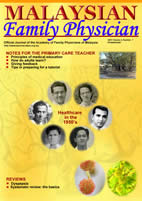DOC'S LIFE
HEALTH CARE IN THE FIFTIES: PART 2
Reminscences from our Veteran Colleagues
The Reluctant Doctor
It was a quirk of fate that switched K Dharmaratnam from Engineering to Medicine. After obtaining the best Senior Cambridge result in 1941, he studied engineering at the Technical College in High Street (now renamed as Jalan Tun HS Lee), Kuala Lumpur. Sensing growing racial tension among the Malays and the Chinese, he was sent by his family to continue his engineering studies in Colombo, Ceylon (now known as Sri Lanka).Figure 4 Dr Dharmaratnam, then and now
 While in Colombo, he was persuaded by a friend to try for the Medical Entrance Examination. He was again the best student, and was pushed to study Medicine at the University of Colombo. Tuition fees were free and he only had to pay 60 rupees a month for lodging. Each medical student had a cadaver to dissect. He was also a keen sportsman and played badminton for Ceylon against Malaya in 1948. He worked for a few years in Ceylon after graduating in 1952.
While in Colombo, he was persuaded by a friend to try for the Medical Entrance Examination. He was again the best student, and was pushed to study Medicine at the University of Colombo. Tuition fees were free and he only had to pay 60 rupees a month for lodging. Each medical student had a cadaver to dissect. He was also a keen sportsman and played badminton for Ceylon against Malaya in 1948. He worked for a few years in Ceylon after graduating in 1952.
He was transferred to Kluang District Hospital after a few months. Although there were only two doctors, British volunteer army physicians managed referred cases. His stint in hospital was short and soon, he was persuaded to run a private practice in Batu Pahat after the previous doctor was shot dead by the communists. There were four general practitioners in Batu Pahat in 1956 and they worked from 8.30 am to 5 pm. Night and 24 hours clinics were non-existent. It was common practice then for private doctors to work part-time at the Batu Pahat District Hospital from 5-8 pm for $500 a month. There were no panel patients and medical leave from private clinics were not accepted by employers Despite reasonable income as a GP, Dr K Dharmaratnam realised that he preferred non-clinical work and rejoined government service as a Batu Pahat District Health Officer in 1958 before he was awarded a WHO scholarship to do Diploma in Public Health at the University of Singapore. As a health officer, he was given a driver’s allowance of $60 and mileage claim of 40 cents per mile.
He remained an active sportsman and represented the country at tennis in 1962 despite holding a Ceylonese citizenship. He forfeited his Malayan citizenship when he overstayed in Colombo and was at a quandary. After returning to Malaya he realised that the much anticipated racial riot did not happen and Malaya was prospering while there was unrest in Ceylon. Although there was a threat from Indonesia, he reapplied and regained his Malaysian citizenship in 1966. Dr Dharmaratnam was posted to various parts of the country before retiring in 1981. As a writer of seven books on religion, he received regular invitations to speak both locally and abroad. He was decorated with a ‘Golden Shawl’ for his speech on the Mahabharatha in Coimbatore, South India in 1992. He still does locum in his spare time.


